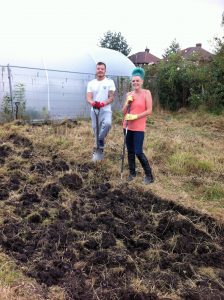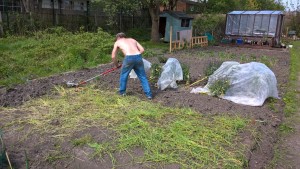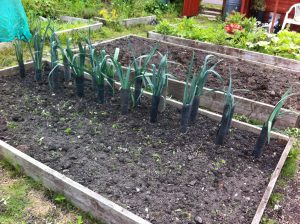Clearing a New Plot
 So you’ve just taken on a new allotment – be ready for some hard work. Contrary to popular belief plot holding is not easy and requires a lot of time – weeds grow faster than the plants you want!
So you’ve just taken on a new allotment – be ready for some hard work. Contrary to popular belief plot holding is not easy and requires a lot of time – weeds grow faster than the plants you want!
The chances are that the previous tenant left at the end of the summer and you get the plot when a great crop of weeds and brambles have covered it. The weeds can give you an idea about the kind of soil you have on your plot. Nettles, docks, buttercups and daisies all indicated an acidic soil. Docks love damp conditions. Mares tails (Equestum Arvense) also like acidic soil. Weeds also give an indication of fertility – lush tall growth indicates good fertility – pretty obvious really.
Armed with information about the type of soil you have you can start to plan what will grow well and what you will have to do to make the things that wouldn’t normally be happy in your type of soil grow well.
So where to start?
There have been a few people who have taken on a plot covered in docks and other perennial weeds, and happily run a rotivator over it. The perennial weeds will grow from a root fragment and so chopping them up and tilling the soil is a great way to propagate and ensure you have a plot absolutely covered in weeds a few weeks later. At this point some people give up!
If you are OK about chemicals, spray the plot with Roundup or similar, wait for the weeds to die and then rotovate. Sounds pretty simple, certainly less effort but you need to trust the chemical companies information and not mind growing food on the soil you just sprayed with chemicals.
If you prefer to be organic then you have some hard work ahead. First decide how much time and energy you have. There are few people who can clear a plot in one go or even a week. You can cover sections with thick plastic, (be aware that carpets are often treated with fire retardant and will normally have been cleaned using all sorts of chemicals so we don’t allow them on our site), or tarpaulins (if you have them) these will hold back the growth until you can get to that section. If you can afford to leave the area covered for a year or so then most of the weeds will die. However you may not want an area out of production for that long, so just use the covering as a holding method.
Now take a small section at a time starting at the front of your plot – your moral will be boosted far more if when you arrive at your plot you can see a clear area with the things you have planted growing in it. There is nothing more disheartening than arriving at the plot and having to wade through weeds to get at the bit you’ve worked.

Six foot by fifteen is about what most people can handle at any one time but if you’re young and fit you might manage more. Start taking off the surface grasses and short rooted weeds with a spade – the resulting turfs can be stacked to eventually form loam. The deeper rooted perennials (like docks) need their roots digging out. These are the devil to deal with. If you add them to a cold compost heap they will happily grow on. You can try chopping them to weaken them and add to a hot compost heap. Other methods are drowning them in a barrel of water for 3 weeks or tying them in a plastic bin bag for a few months.
Having completed clearing dig over with a fork, this will break the soil up and enable you to remove any weed roots. Watch out for bindweed – this is one that spreads from a small bit of root. A small stem is probably growing from a foot of tubular root snaking along a few inches below the surface.
One exception to the rule is Mares Tail or Horse Tail. This wonderful weed has survived since prehistoric times and has roots down to Hades, well 5½ metres anyway. The only thing that will kill them is ammonium sulphate, a weed killer often sold for brushwood clearance. The problem with it is that you can’t plant for 8 to 12 weeks after use. It’s not approved for organic growers but is a safe and simple herbicide.
As you clear your patch, consult your overall plan and prepare the ground accordingly. If it’s getting late in the season then consider a green manure. As you get towards the end of your plot you will probably have an army of weeds sprouting behind you. They never stop! Most of these will be annual weeds whose seeds have been germinated by your clearance exposing them. Don’t worry – you can just hoe them off but it does sometimes feel like the ‘Forth Bridge’ – a never ending battle.
Remember that there are plenty of people on the site who are happy to help – if you’re struggling come and talk to us in the hut on Sunday, we’re open between 11 and 12.30.
You are encouraged to take part in a number of different activities and competitions – the council will be looking for the best newcomer across all the Manchester sites – judging is in July /August. The Society have a show in September where there are classes for new plot holders to exhibit there veg. and flowers. We also have a number of other events throughout the year which you are invited to. Watch for notices around the site or visit the hut regularly to keep up to date.
Good luck and happy gardening!

